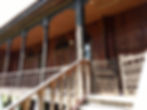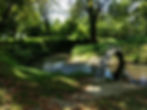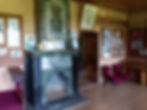- Shawn Basey
- Oct 30, 2018
- 6 min read

Konstantin Gamsakhurdia is one of the more famous writers in modern Georgian history, and most noted for his work the Right Hand of the Master, which was my first introduction to him. The book chronicles a love triangle between King Giorgi I, the architect of Svetitskhoveli Church, Konstantin Arsakidze, and the sister of Arsakidze’s wetnurse, Shorena. The tryst is set in the backdrop of a feuding medieval Georgia, where the country is being pulled apart by both external and internal pressures, and a fairly ineffective king who’s more interested in hunting does and chasing tail than effective governing. It’s a really great read, and I highly recommend it to anyone who’s looking to get a better look at Georgian culture and history.

the gate to the museum in Abasha
He was born in Abasha, Georgia, and was the father of one of the more controversial figures of modern Georgian history, the first president of the free and independent Georgia, Zviad Gamsakhurdia. Konstantine himself is far from controversial, and is beloved by most Georgians as one of the dominant players of the Georgian-Soviet literature scene. Though he was born in Abasha, he grew up mostly in Kutaisi and then went off to St. Petersburg. During World War I, he lived in Germany, France, and Switzerland, where he was becoming acquainted with much of the European intelligentsia, and even developed a friendship with the German writer, Thomas Mann.
Just after Russia’s collapse, Georgia declared independence and sought aid immediately from Germany, since they would have had leverage with the Ottomans and be able to hold off the Ottoman advance on Georgian territory. At that time, Konstantine began his Georgian fame, as he became an attache in the Georgian Embassy to Germany and started work helping to repatriate Georgian prisoners and returning them to Georgia, which was now allied with the Kaiser.
Konstantin soon returned to his native Georgia, which was now a free country, and worked editing Tbilisi-based literary journals. He joined the opposition after the Bolshevik takeover, and as he wrote, he kept getting labeled by the government as “decadent”, which was one way of saying that the author’s works would never see the light of day. In 1924, the Soviet government finally tired of him and the sent him off to the Gulag at the infamous Solovetsky Islands network, though rather than having to do hard labor, he was forced to set upon translating Dante -- one can argue which would have been worse, but I wonder if Stalin and Ordjonikidze made it into Konstantin's version.

the lovely woodwork on the museum
The Gulag’s icy re-education camp seemed to do its work, as after Gamsakhurdia’s release, he tended to not write things so openly critical of the regime, and somewhat enjoyed the support of Beria for a time. He focused mostly on historical fictions, which for the most part kept him out of trouble, and it was at the height of the Terror that he started to write The Right Hand of the Master. He managed to survive Stalin and his later career continued on the path of historical fictions and the extraordinarily safe job of criticizing foreign imperialist authors.
The Abasha Museum
Knowing that such a titan of Georgian culture was from a town that was close to my wife’s, I really wanted to go and visit his house museum. So team Saint formed up again. My wife, her parents, and myself jumped into the car and headed to Abasha.
rent your own car from Discover
The museum isn’t remotely near the center. It’s actually quite far into the middle of nowhere, and access would be just about impossible without a car, so a taxi from the center would be necessary for those automobile-less explorers. But don’t expect taxi drivers to necessarily know where it is, and in that regards, GPS is helpful, but the GPS is also a bit off, as some roads don’t exist on Google maps, and there are a couple of roads that are on the map that don’t exist in reality.
After stopping to ask some locals a few times, we finally managed to find the museum. There was a small, empty parking lot out front, and a sign hanging with a phone number. The gate was unlocked, and just past it there was a giant concrete slab of some long abandoned construction project. It wasn’t looking good. We called the number, and the lady on the other end told us to make ourselves comfortable and the museum attendant would be along shortly.

a traditional Megrelian house, or "oda"
Past the construction, there was a small concrete stage to the side, and then what we assumed was the museum itself, a Megrelian style house, or an oda. The oda had a great deal of beautiful, detailed wood work, and this was where we assumed Gamsakhurdia was born and spent his early years. We wandered past the oda, and there was another small house, perhaps a kitchen (kitchens in the older days were often separate from houses due to fires, something common also on American plantations). Past the kitchen, there was a small river, which Gamsakhurdia had once described, “I was born on the smallest river of the world.” The river connected his village with a nearby village, one village his father was from and the other his mother was from.

a river runs through it
The river is a beautiful and scenic area, and there was a small well and gazebo there. I imagined the writer and his family having many outdoor eating events there, singing folk songs and chowing down on grilled pork mcvadi. But I would soon find out all my fanciful imaginings about the idyllic life of the author was something of a novel itself.

an awesome fireplace if it weren't just covered in stickers
The curator finally showed up and let us into the oda. There was one large room with a neatly decorated fireplace. The walls were full of old photographs of Gamsakhurdia, mostly of him traveling around Georgia and his time spent with khevsur communities doing research on one of his books. On another wall, there were some cases which included some letters, pens, and other paraphernalia. There was also a bed and a desk.

Konstantin's favorite paperweights
The curator explained that Gamsakhurdia was only born on this property and left for Kutaisi shortly after and he never really lived here. And in fact, this oda wasn’t even here in his time. There was another house, but it had burned down some hundred years ago. Then his mother had lived in a smaller house, which had also burned down. This oda was built specifically as a museum in the 1980s, but when they built the oda they didn’t even bother trying to recreate the house that Gamsakhurdia was living in, they just built a traditional looking oda. Nothing special.

lots of random paraphernalia
The furniture and paraphernalia there came from the house where he lived in Tbilisi, called the Kolchuri Koshka, or the Colchetian Tower (Colcheti was the land where Jason and the Argonauts explored, which is modern day Samogrelo, where Abasha is located).
They do have occasional festivals at the stage around the time of Gamsakhurdia’s birthday, and there were vague plans to either finish building the hotel that had started in Soviet times, or perhaps to build another hotel. I couldn’t quite tell. Either way, there didn’t seem much progress on it.
This led me to visiting the museum in Tbilisi, the Kolchuri Koshka.
The Kolchuri Koshka
The tower where Gamsakhurdia did most of his living and writing is located way up in Upper Vera, which at the time would have been a kind of remote suburb overlooking the rest of the city, but has since been swallowed by sprawl, vast and brutal apartment creations having spawned up from the blood of good architecture, rising up like the skeletal hands of the free market urban planning ravishing the city.

the way to the tower
We took the number 4 marsrhrutka, which goes along Barnovi Street, and walked up to Gogebashvili Street, and then finally Gali Street. We made it to the entrance, which was this huge barren wall and gate, where there was a small camera. No signage. At this point we realized that maybe this wasn’t a museum at all, but just somebody’s house. Trying to peer over the wall, there didn’t look to be any old buildings at all, but rather some very nicely kept up mansion. There was indeed a tower on the mansion, and I suppose that was an updated version of it. But it was clearly not open to the public.

the tower is over the fence
But maybe there was another entrance. So we walked along the three meter walls and went down another street. No luck. Someone in a neighboring house came out.
“Is Gamsakhurdia’s house, the Kolchuri Koshki, around here?” I asked.
The man said, “That’s it, behind the wall. See the tower?”
“Yeah, but is there like, a museum there or anything?”
“Sort of. You can knock on the door and maybe the guy who lives there will show you around. It’s Gamsakhurdia’s grandson living there now.”
“So no museum?”
“Maybe there will be a museum,” he said.

not an entrance to a museum
Thus ended my search for some worthy monument to the writer.













